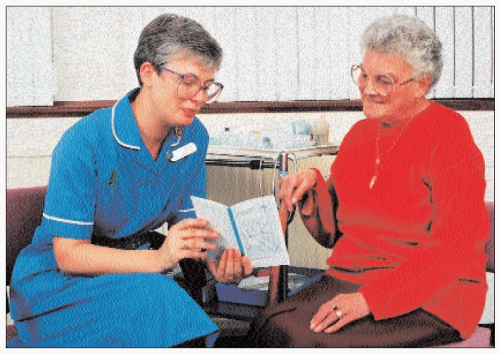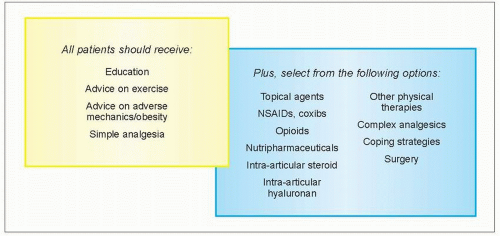Principles of Management
Introduction
In the management of osteoarthritis, there are several tools available (5.1). There are a wide number of options, including non-pharmacological, pharmacological, and surgical options, which may be selected and tried for the individual patient. The management plan has to be individualized, taking into account factors such as: severity of pain and disability; constitutional factors (e.g. obesity, muscle weakness); psychosocial factors; co-morbidity; concurrent drug therapy; and patient beliefs. With respect to choice of additional interventions, the evidence for efficacy is clearly important, although other factors that will guide decision-making include: the safety profile; the availability and practicality of the intervention; its mode of delivery; the cost of treatment; previous experience of the patient; and physician and patient preference.
Education
As with any chronic disease, patient education is paramount, particularly as evidence suggests that patients with high degrees of self-efficacy have better outcomes in terms of pain and disability. Ideally, education should take a cognitive approach, as enhanced problem-solving strategies and behaviours are the goal, rather than simple knowledge. A variety of approaches have been used, but essentially the fundamental principles are:
Messages need to be given that are consistent.
There needs to be an exploration of the patients beliefs and logical constructs so that the educational message is either not dissonant with this, or the underlying beliefs are challenged when required.
Educational materials need to be culturally relevant and appropriate to the educational level of the recipient.
While these principles are easy to elucidate, putting them into practice is a considerable challenge within most health and social care services. Doctors and allied health-care professionals clearly have a role in this, but patients may receive a lot of their information and, indeed, possible misinformation from a number of sources (5.2, 5.3). There are a wide variety of sources that provide information on osteoarthritis (e.g. patient literature, interactive programmes, websites, and books). Many patients receive much of their education from non-professionals, such as friends and family. Education, therefore, may need to take place at a societal, as well as personal level. This is again a major public health challenge.
 5.3 Patient education and information access should be given to everyone with osteoarthritis.
Stay updated, free articles. Join our Telegram channel
Full access? Get Clinical Tree
 Get Clinical Tree app for offline access
Get Clinical Tree app for offline access

|







